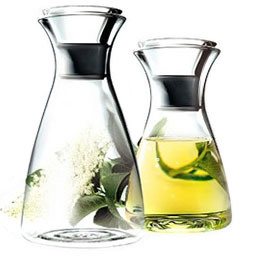 The safety and aroma appeal of fresh-cut fruits and vegetables could be improved by using a right combination of flavors among the antimicrobial essential oils (EOs) and the target fresh-cut produce. The paper of Ayal-Zavala et al. (2009) describes some premises, listed below, about the potential addition of EOs to fresh-cut produce.
The safety and aroma appeal of fresh-cut fruits and vegetables could be improved by using a right combination of flavors among the antimicrobial essential oils (EOs) and the target fresh-cut produce. The paper of Ayal-Zavala et al. (2009) describes some premises, listed below, about the potential addition of EOs to fresh-cut produce.Microbial and aroma attributes limiting safety and sensorial quality of fresh-cut produce
Among the wide variety of fresh-cut vegetables on the market, the most common are vegetable mixtures served as salads. However, there are important considerations on quality and safety of fresh-cut produce that should be discussed. Fruit decay and quality loss of fresh-cut fruits and vegetables are enhanced by processing and storage conditions. Fresh-cut products tissues decay more rapidly and their physiology significantly differs from that of intact fruits and vegetables.
Among the quality attributes limiting mostly the shelf-life, there are microbial growth and sensorial decay. Microbial contamination can seriously compromise the safety and shelf-life of fresh-cut fruits and vegetables. The high content of organic acids and sugars, present in the fruit and released by tissues after peeling and cutting, can be a good medium for bacteria, yeast, and mold growth.
Microbial and aroma attributes limiting safety and sensorial quality of fresh-cut produce
The most common microorganisms are those belonging to Pseudomonas genus, Erwinia herbicola, Enterobacter agglomerans, lactic acid bacteria, molds, and yeasts. The bacteria are more usual in vegetables due to their high pH and are agents of serious foodborne diseases.
The sensorial appealing is the most important factor affecting the acceptance degree of the consumer and his purchase decision the fresh-cut produce. The color, flavor and aroma, and firmness are the main indicators of organoleptic quality and depend on fruits and vegetables physiology, which is influenced by maturity stage, harvesting handling, and processing. For reducing decay rate, chemical synthetic additives could be used, but the consumers are concerned about chemical residues in the product and their impact on human health and environment. For these reasons, one of the major emerging technologies to reduce quality loss and to assure safety of fresh-cut fruits and vegetables is the application of natural additives.
Antimicrobial and aromatic potential of EOs
An EOs is a concentrated, hydrophobic liquid containing a mix of antimicrobial volatile aroma compounds; it is commonly extracted from plant tissues by steam distillation, maceration, cold pressing, and solvent extraction. The EOs are used in perfumes, cosmetics, and in the flavoring food and drink area.
Many studies have shown the antimicrobial power against both bacteria and molds of some EOs, such as garlic, cinnamon, thyme, oregano, clove, basil, coriander, citrus peel, laurel, ginger, rosemary, and peppermint oils. There are several volatile compounds in the EOs that have antimicrobial activity and flavoring properties. Some of the most representative and studied compounds are terpenoids, organic sulfur compounds, aldehydes, and alcohols.

The terpenoids are the most studied compounds for the antimicrobial properties, the most well-known terpenoids are menthol, camphor, geraniol, eugenol, thymol, carvacrol, limonene, carvone, and cinnamaldehyde. The organic compounds containing sulfur are typical of Alliaceae, they are abundant in garlic, onion, and leek, etc. In these years, the antimicrobial activity of some organic sulfur compounds (diallyl sulfide and dimethyl trisulfide) present in garlic essential oil has been assessed against Enterobacter aerogenes, Escherichia coli, Salmonella spp, Listeria monocytogenes, Yersinia enterocolitica.
The most cited compounds are registered in many regions as flavorings in foodstuffs, thus they are considered to present generally no risk to the health of the consumer.
 Connection between aroma of EOs and aroma of fresh-cut produce
Connection between aroma of EOs and aroma of fresh-cut produceFor the application of EOs as fresh-cut fruits and vegetables preservatives, it is fundamental considering the sensorial impact of EOs on fresh-cut product. The first aim of the market is to satisfy the palate of the consumers
Thus, it is important to find a right combination of flavors among the antimicrobial EO and the fresh-cut produce. Most vegetables present herb and spice notes, thus they could be combined with oregano, coriander, garlic, thyme, laurel, rosemary, and ginger oils; on the contrary, fruits present sweet and fresh aroma notes, thus they could be combined with cinnamon, clove, citrus, basil, and peppermint oils.
The idea of adding an extra flavor to the EO-treated product could be perceived within the philosophy of the traditional art of seasoning. Fresh-cut broccoli, cabbage, potato, cucumber, carrot, onion, and tomato are marketed as ready-to-eat dressed salads, or as ingredients for other dishes.
The authors have reported several examples on which EOs could be combined with fresh-cut fruits and vegetables according to their aroma notes.
 State of art and future perspectives of the scientific research
State of art and future perspectives of the scientific researchIn these years, the scientific research has been focused on the effect of EOs on microbial activity of fresh-cut produce, despite the global effect, which regards sensorial consumer acceptance.
The authors have reported some studies on fresh-cut apples and fresh-cut melon about the effect of the addition of EOs in the edible coatings. In general the results showed that the EOs improved the safety but modified the original taste of the product.
A study on washing with oregano essential oils of fresh-cut carrots and lettuce showed the antimicrobial efficacy of EO, but as regards the sensorial quality carrots were acceptable while lettuce was rejected by sensory panel.
The authors have underlined the necessity to optimize the use of EOs as natural additives for fresh-cut produce, so that to satisfy the requirements of consumers of natural preserved and flavorful, healthy, and convenient fruits and vegetables.
The authors have concluded listing the research topics that should be studied:
- Identify consumer preferences;
- Identify trends in fresh-cut fruit and vegetable consumption;
- Identify right combinations of flavors between fresh-cut product and essential oil;
- Identify the optimal application procedure and required doses to achieve both antimicrobial and sensorial efficacy.
http://onlinelibrary.wiley.com/doi/10.1111/j.1750-3841.2009.01294.x/abstract








